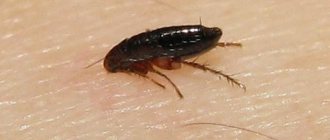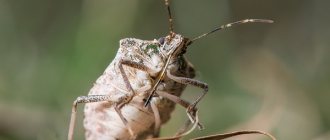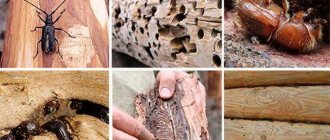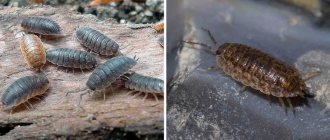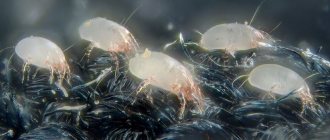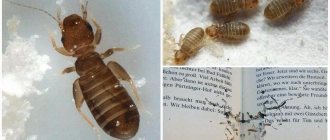Description of appearance
In our area there are several types of shashel - furniture, house. Each of these pests causes significant damage to wooden structures, furniture, even books and leather goods. Many people know what a shashel looks like, but they don’t realize that this is it:
- elongated body with a durable shell;
- color brown or black;
- the size of pests is several millimeters;
- on the head there is a long curled mustache with stripes;
- three pairs of long, fairly powerful limbs.
The woodworm itself is harmless and does not pose a threat to human life or well-being. But living with him under the same roof threatens serious damage to property.
Important!
The shawl larva is a thick caterpillar of a dirty yellow color with a well-developed mouthparts. It does not leave its burrows, so it is difficult to see it. But characteristic sounds give away their presence.
A photo of the shashel is presented below; you can clearly see all the features of the body structure and color scheme.
Shashel
How to understand that a bark beetle has appeared in the house?
The appearance of a bark beetle in a house can be determined by the following signs:
- Small holes in wood measuring 1-3 mm, near which there will always be wood flour of brown or light yellow color
- A creaking, rustling or ticking sound at night, made at night. This sound is characteristic of larvae that constantly gnaw passages inside the tree. In the last century, “night ticking” foreshadowed the death of one of the household members. And there is a small amount of truth in this, because the corroded parts of the house can collapse at any moment and injure or kill a person. Nowadays, few people believe in superstitious signs, but at the first sign of the appearance of bark beetles in the house, they take active measures to destroy it
- Visible subsidence of the house due to a decrease in the diameter of the contaminated log.
Features of life
The presence of shashel in a tree is indicated by a specific sound, similar to the ticking of a clock or chirping. It reproduces during the mating period of beetles. You should look for them on the surface of the wood. Because woodworms leave their burrows during mating.
The location of the nest, as well as the degree of infection, is determined by the sound. The more intense and louder the ticking, the more pests there are in the house. Another characteristic sound is created by the larvae, which gnaw wood day and night with a special appetite. The burrows are filled with excrement, which crumbles over time, resembling sawdust or wood dust.
Adult beetles spend most of their lives in the nest, making more and more new passages in different directions. But the main pests are the larvae, which do not leave their burrows at all.
On a note!
Infection of a house occurs during construction, when using material with larvae, cabbage eggs, in old wooden houses with cracks in the wall, window sills, and doorways. And also in a new design, if no attention was paid to careful processing of the wooden components.
Peculiarities of shashel life
How to identify tree infestation
Lumber affected by insects has characteristic differences:
- visible remains of tunnels under the bark of the wane - bark beetle;
- abnormal lightness of the board, holes Ø 2-5 mm on the surface, while the board appears intact, there are no moves - termite or shashel;
- wood flour (dust), sometimes black-brown in color - all insects.
Wood affected by pests is “not treated”, because insects always strive to capture the largest space and are distributed throughout the entire element or structure, as long as their number is sufficient. If signs of a beetle are detected, you should refuse to purchase the material. If the beetle is found in existing stocks, the material should be rejected and the infested products should be burned.
The presence of larvae in an existing structure can be determined by ear - they make a characteristic grinding or tapping sound as they bite into the wood. In the old days, this sound was called the “death clock”, because practically nothing was known about the possibility of fighting.
Larval development
The shashel develops in the egg from 1 to 4 weeks. The first stage larva is a caterpillar. Starts sabotage immediately after birth. Gnawing through numerous passages. She molts periodically and gradually increases in size. The last stage larva reaches 4 mm.
It is difficult to say how long the shawl beetle lives in the larval phase. According to various sources. develops in the conquered territory from 3 to 15 years. At the last stage, it goes deep into the tree and pupates. It emerges to the surface as a wood-boring beetle that has already formed. But after mating, it returns to the tree again to build a nest and lay eggs.
Chashel is the main enemy of wood
One of the most dangerous pests that settle in a tree is shashel. It is a misconception to think that this pest can live in cereals or other food products. This black or dark brown wood-boring beetle is small in size (its length is 3-4 mm), and it can even be confused with flies. But to be sure whether this pest is in the house, it is advisable to know what a shashel looks like, photo below.
The beetle often chooses wood with a 5-6-year service life and spoils it very quickly; after a year, the result of its actions is noticeable to everyone. When a shawl beetle lands on a wooden surface, it immediately begins to bite into it in order to create tunnels and lay eggs in them.
Shashel larvae also threaten the integrity of the wood; they gnaw long tunnels and tightly clog them with digested pulp and their own excrement. Then they try to find the most comfortable place in the tree, relative to temperature, where they pupate. This pest beetle reproduces with great activity. Females lay about 80 eggs in their nest, from which larvae emerge.
The larva can live in wood for up to 7 years (in some cases up to 15 years) and drill about 40 km of passages during its stay. It is considered the main culprit in damage to timber.
Fighting methods
Methods of fighting insects How to get rid of shawl, there are several methods. The choice depends on the degree of infestation, financial capabilities, and personal preferences.
- Treatment with insecticides. Antiseptics and broad-spectrum drugs are used.
- The use of folk remedies. A special mixture is prepared that blocks the access of oxygen to larvae and adults, causing death.
- Exposure to microwaves. Carried out by specialists using modern equipment. The generator produces microwaves that are directed at the infested wood. It warms up and kills shashel larvae and beetles. The disadvantage of this method is that it is labor intensive and expensive.
- Dry steam treatment. The action is similar to the previous method. Dry steam heats the wood and reduces humidity. In such conditions, the shawl larvae and the beetles themselves die.
- Fumigation - fogation, fumigation. Hydrogen phosphide is used, which is capable of penetrating deep layers of wood and destroying shashel larvae and adult beetles.
At home, a chemical method is used using insecticidal preparations and folk remedies.
What problems arise when fumigating against bark beetles?
When carrying out fumigation against bark beetle, problems may arise both on the part of the room being treated and on the part of the Customer due to misunderstanding of the process and the principle of treatment.
Very often, a room has multi-layered, insulated and sheathed walls, between which a vapor barrier is laid that does not allow gas to pass through. In order to solve this problem, a specialist drills technical holes in the walls and places small bags of the drug inside. Thanks to this method, gas can penetrate into inaccessible contaminated material.
If a wooden house is not fully completed and does not have a roof, then the dome fumigation method is used. The structure is placed under a sealed film dome that does not allow gas to pass through, resulting in the desired result being achieved.
Problems also arise with Customers who require only one floor to be treated, not realizing that the gas will in any case spread throughout the entire house. However, its concentration (per one floor) will be too low to destroy the bark beetle larvae.
Proven Recipes
If a shashel has started in a wooden board, getting it out of there is problematic. But you can make sure that he either crawls out on his own or ends his life in a hole. Initially, you can use folk remedies.
- Boil 10 liters of water, mix hot with 250 g of potassium fluoride. Stir for 5 minutes, pour into a spray bottle. They process the wood from shashel. Work should be carried out with rubber gloves.
- To 10 liters of lime turpentine add 500 g of wax, paraffin, 300 g of creolin. Stir until smooth and process the wood.
- 3 liters of turpentine are mixed with 1 liter of gasoline. Using a brush, the wood is removed from the shashel.
A significant drawback for all traditional methods is the unpleasant, pungent odor. It is better to fight shawl in this way in a non-residential building or from the outside. Wood soaked in kerosene and gasoline becomes a fire hazard. Therefore, before using the product, you need to weigh the pros and cons.
How to deal with shashel
Where to begin?
The fight against shawl in the house should begin with searching for the habitat of the beetle larvae. To do this, carefully inspect all the furniture, floors, walls, if they are wooden. By the way, upholstered furniture is no exception either. Its internal parts consist of solid timber, so they may well become a home for the wood-boring shashel. So sometimes you have to dismantle the sofa and armchairs to find the home of these pests.
If you are buying timber for construction, inspect it carefully. If holes are found, refuse this purchase and order building materials elsewhere, since it will be very difficult to cope with large volumes of affected wood. The affected timber is not suitable for construction. Within a few years, only dust will remain from the tree.
If you find shashel on furniture or on garden trees, be sure to treat the wood with fluoride or sodium fluoride. You can buy these chemicals at any gardening store. To use, dilute 250 g of product in 12 liters of hot water. Stir and cool the water. Pour the solution into a spray bottle and spray the fruit trees. If shashel is infested in furniture, soak a rag in this solution and wipe all, even non-infected, furniture.
In the fight against shashel, all means are good. A mixture of creolin, paraffin, wax and turpentine helps to kill shashel. To prepare the product, take 30 g of creolin, 50 g of paraffin, 1 liter of turpentine and 50 g of wax. Mix all the components and treat the furniture with the resulting solution. On fruit trees, use a heated solution and apply it with a brush.
A solution based on turpentine will also help to remove shashel. To do this, dilute 1 liter of vaseline oil, 2 pieces of melted soap, 1 liter of gasoline, 100 g of naphthalene and 1 liter of kerosene in three liters of turpentine. Thoroughly stir the anti-shashel product and wipe the furniture with it using a sponge, and go over wooden structures with a brush. After this treatment, melt the paraffin and coat the passages with it. After a week, repeat the treatment with the above solutions and lubricate the passages again.
If the holes in the furniture are small, they can be covered with regular Vaseline, and if possible, fill the passages with Vaseline.
If the damage to the wood is too severe, you can entrust the destruction of the shashel to professionals. Some companies offer to destroy shashel using microwave irradiation. This method of combating the borer is especially effective when affecting wooden houses or indoor wood trim. Microwave equipment has proven itself to be excellent. The irradiator is reliable and easy to use. The thickness of the structure being processed can reach up to 25 cm. This allows you to kill the shashel even in the deepest layers of wood. The advantage of this method is that microwave equipment makes it possible to remove the shashel from wood under layers of clay, paint and varnish. This method of processing wooden structures is absolutely safe, since the irradiation is carried out using remote control. After irradiation, no toxic chemical traces remain, and disinfestation can be carried out at any time of the year.
Professional preparations
Professional preparations for the pest Treatment of wood from shashel is carried out with antiseptics and insecticides.
- Antibug. A universal product against all wood pests. Destroys adult shawls and larvae at different stages of development. Process thoroughly once. But to consolidate the effect, repeated treatment is recommended after 14 days. Used for prevention. The remedy for shashel in the house is not highly toxic, but it is necessary to work with rubber gloves.
- Antishashelin. Destroys all types of wood borers. The composition contains silicones that can penetrate into the deep layers of wood and destroy shashel and its larvae. Used for processing old wood, fresh wood, furniture, antiques, floors, any wooden structures. Preserves the integrity of the tree and does not spoil the appearance.
- Woodtex. According to customer reviews, one of the most effective drugs. Helps destroy shashel and protects against re-infection for six months. It is recommended to treat several times throughout the year, every 3 months. The product is poured into the shashel passages with a syringe. Seal the holes on top with Vaseline and paraffin. For prevention, the procedure should be carried out in the middle of summer and winter. If the wood is severely damaged, treat the surface with a brush and apply a thick layer of the preparation.
- Lignofix. The antiseptic does not contain toxins. After use, it does not lose its properties for 10 years. Destroys chitin-containing insects. It enters the body, disrupts biological processes, and leads to death.
In order not to think about how to quickly and effectively get rid of shashel, it is necessary to inspect wooden structures twice a year and carry out preventive treatment.
Why is the bark beetle dangerous?
Bark beetles are absolutely harmless to humans and animals. They do not bite, do not carry dangerous germs and bacteria on their paws (like flies, for example), and do not buzz under the ear. Their natural habitat, main shelter and food are trees and, accordingly, any wooden buildings.
The adult female lays eggs with her future offspring in the pith, the succulent and vital part of the tree. The larvae are completely and completely protected from any adverse influences: cold, heat, pesticides, birds, etc. For 3 years they live, grow and feed on the tree, gnawing holes of various shapes. In 24 hours, one larva eats up to 10 grams of wood! Thanks to simple arithmetic, you can calculate how much damage just one bark beetle larva can cause to a wooden structure! A particular risk is damage to the building's supporting structures, which can collapse at any time and cause injury or even death to a person.
Shashel in the kitchen
Housewives often find small dark-colored bugs, similar to shashel, in flour and cereals. In the kitchen, the woodworm lives only in wooden structures and is not interested in food supplies. This is another type of pest that looks like a shashel.
The methods of fighting are extremely simple. Throw away the contents, thoroughly wash the containers in which supplies were stored, and carry out a general cleaning of the cabinets. Wash the furniture with a vinegar solution.
Shashel does not live in cereals. This is a completely different type of pest. Therefore, there is no point in using antiseptics and insecticides in this case.
